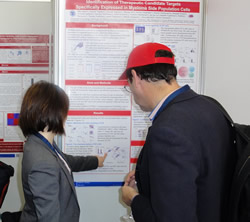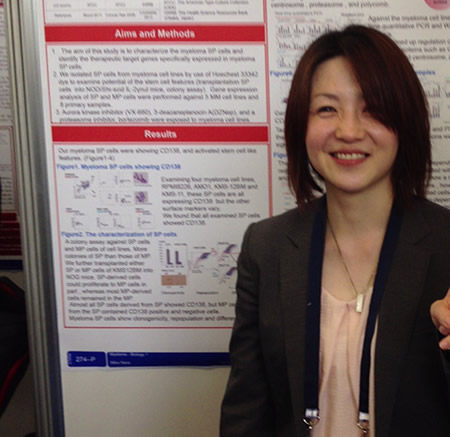17th EHA Congress Travel Award 受賞レポート 奈良 美保

名前:奈良 美保【秋田大学大学院医学研究科 血液・腎臓・膠原病内科学分野】
発表日時:2012年6月15日
発表形式:poster
Title:
Identification of therapeutic candidate targets specifically expressed in myeloma side population cells
Abstract:
Background: Multiple myeloma (MM) is characterized by the accumulation of a population of malignant plasma cells within the bone marrow. Cytotoxic chemotherapy-based treatment is not curative, however, and the disease eventually recurs. Although currently available anti-MM strategies are effective at targeting the bulk of tumor cells, it is not clear that these agents are targeting the tumor-initiating subpopulation, or cancer stem cells. Side Population (SP) cells express high levels of various members of the ABC transporter family, which are responsible for their drug resistance. A recent work by Jakubikova et al (Blood, 2011) demonstrated that SP cells in MM have shown to exhibit stem cell like characteristics as well as high tumorigenicity.
Aims: The aim of our study is to identify gene/proteins specifically expressed in myeloma SP cells, which could be essential therapeutic targets.
Methods: We isolated SP cells from MM cell lines by use of Hechest 33342 dye to examine potential of tumorigenicity (transplantation SP cells into NOD/Shi-scid IL-2γnul mice).Gene expression analysis of SP and non-SP cells were performed against 5 MM cell lines and 8 primary samples.Aurora kinase inhibitor (VX-680), 3-deazaneplanocin A(DZNep), and a proteasome inhibitor, bortezomib were exposed to RPMI 8226 and AMO1.
Results: We found that myeloma SP cells expressing CD138 exhibit greater tumorigenetic potential than non SP cells. Gene expression analysis of 5 cell lines and CD138-positive primary samples revealed that, in SP cells, expression of cell cycle (e.g. CCNB1)-, microtubule attachment (e.g. BIRC5)-, mitosis or centrosome (e.g. AURKB)-, proliferation (e.g. TOP2A)-, polycomb (e.g. EPC1, EZH2)- and ubiquitin-proteasome (e.g.PSMA5)- geneswas significantly stronger than in non-SP cells.On that basis, we used an aurora kinase inhibitor (VX-680 for AURKB), histone methylation inhibitor (DZNep for EZH2) and a proteasome inhibitor (bortezomib for S20/S26 proteasomes) against RPMI 8226 and AMO1.Of these, bortezomib reduced the SP fraction more effectively than the other agents due to its ability to reduce levels of phospho-histone H3, EZH2 and PSMA5.This suggests bortezomib has a greater range of targets than other agents and could include cell cycle, centrosome, polycomb and proteasome genes/proteins.
Conclusions: We found that myeloma SP cells exhibit strong tumorigenicity in vivo, and showed that they more strongly express cell cycle (G2/M)-, centrosome-, polycomb- and ubiquitin-proteasome-related genes than non-SP cells. We also demonstrated that reducing transcription of all these genes is necessary when targeting myeloma SP cells, and that bortezomib is capable of shrinking the myeloma SP by downregulating the aforementioned genes.Our approach could be useful for screening new agents with which to target a population possessing strong tumor initiating potential in MM.
EHA congress 印象記:
 この度は2012年6月14日から17日までオランダで開催された、The 17th EHA congressに参加する機会を与えて下さり誠にありがとうございました。
この度は2012年6月14日から17日までオランダで開催された、The 17th EHA congressに参加する機会を与えて下さり誠にありがとうございました。
今までアメリカ血液学会(ASH)には参加したことはあるものの、EHAは初めての参加で、さらにヨーロッパ自体も初めての訪問であることから期待でいっぱいでした。
到着日は、夕方に到着したこともあり、疲れて早い就寝となったのですが、初めてみるヨーロッパの風景に心躍りました。
EHA日程は、初日のスポンサー企業によるSatellite symposia、2日目以降にはEducation session、Simultaneous session、Plenary session、Poster sessionなどが開催されました。私の印象では、ASHよりもプログラム構成に余裕があり、Education sessionも午前と午後とで2回催されるため、自分の興味あるsessionのすべてを聴講することができました。また、会場もASHほどは広くなく、次のsessionへの移動も楽で、余裕をもって過ごすことができ、EHAは有意義なものとなりました。
特に、Molecular Hemopoiesis Workshopのstem cell sessionでは、stem cell研究の最新の話題、また私の研究テーマであるmyelomaのSimultaneous sessionでは、臨床研究に基礎分野を取り入れたデータ解析を勉強させていただきました。
私のポスター発表では、国外の先生と1対1でdiscussionができ、最後には「nice study !」と言っていただくと、お世辞とわかっていながらも大変うれしく感じました。
また今回、EHAに参加された他の日本血液学会の会員の方々と交流する機会を設けていただきました。初めてお会いする先生方とゆっくり食事をしながらお話しでき、帰国後もその先生方と連絡を取らせていただけるようになりました。また、自分の英語力が未熟であることを痛感もいたしましたが、EHA期間中は、国内・国外の先生方とたくさんお話しする機会があり、多くの刺激を受けることができました。
学会期間中に日本血液学会の役員・事務局、また参加者の先生方と食事をする機会にも恵まれました。非常に貴重な機会であり、私にとって大きな刺激となるとともに励みにもなりました。またどこかでお会いできることを楽しみにして、日々の臨床・研究に打ち込んでいきたいと思います。
研究の方法、考え方などを日々指導していただいている田川先生、澤田教授、医局や関連病院の先生方、研究室の方々などの支えがあってこそ、今回発表できたのだと考えさせられたことも、EHAに参加することで得た大切なことだとも感じています。
このようなご機会を賜りました、日本血液学会 事務局、国際委員会の方々に深くお礼申し上げます。
